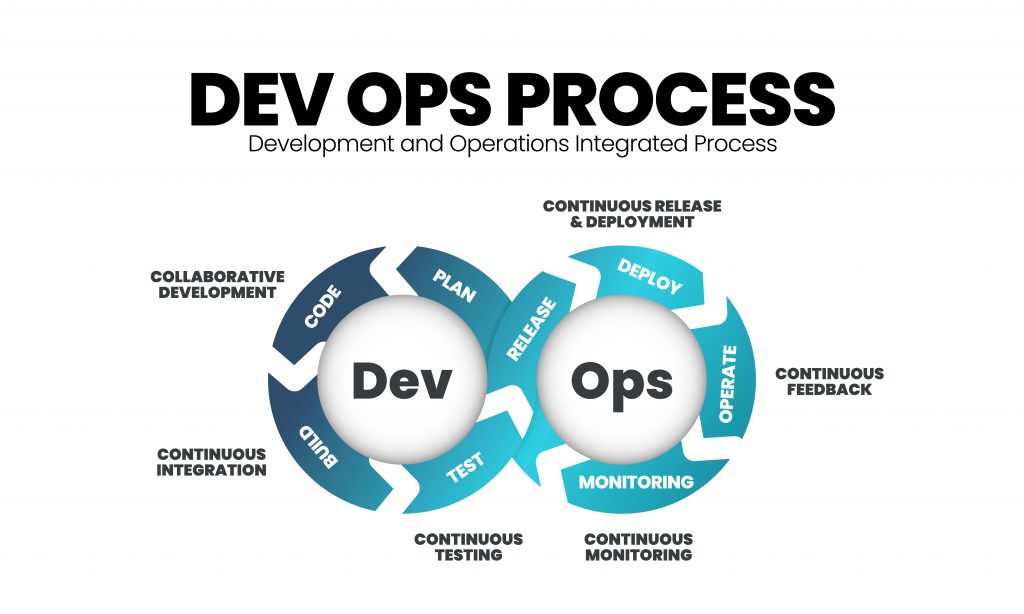As IT Monitoring specialists, why are we part of the observability for DevOps conversation? Simply because DevOps have special needs in terms of observability and therefore, they are key customers for IT monitoring. This blog post continues the observability and IT monitoring discussion, looking this time at how IT monitoring contributes to enabling observability for DevOps.
What are DevOps and how do they work?
The digital business is now massively relying on “as a service” delivery modes, for IT infrastructure as much as for applications or other platforms. This is adding gravity to the field of DevOps, which couples agile application development practices (Dev) with IT Operations (Ops) and gathers a set of methodologies, frameworks, and practices in a continuous, collaborative effort to deliver better applications.
What most distinguishes DevOps is that they work in a continuous process, hence the infinity loop portraying their workflow. And because DevOps are all about agility and collaboration, they can be best supported by a tightly interconnected toolset at each step of the never-ending process that characterizes DevOps, from planning to continuous feedback and integration.

What is observability for DevOps?
Observability for DevOps is the capability to see in real time if code works according to plan, whether it’s during testing, launching or running applications. Such awareness rests on the ability to collect and analyze data from a large variety of sources, including from the underlying high-availability infrastructure supporting such applications.
Therefore, DevOps can be enabled by ITOps teams, making them constantly aware of the infrastructure each business service depends on and through collecting a diversity of data type, provide real-time clues on application performance, and ultimately, on the user experience. In the world of DevOps, optimal infrastructure performance is essential to running successful applications—and constantly optimizing infrastructure is a part of constantly improving how code works.
Infrastructure monitoring is, of course, just one layer of the observability stack. Data needs to be correlated and complemented by application performance monitoring and digital experience management data sources. Through APIs, libraries, agents, and connectors, DevOps, but also PlatformOps and BusinessOps, can access and leverage such data sets, using advanced automation and AI tools to make the digital business fully observable.
The benefits of observability for DevOps
DevOps operating in an environment featuring a robust observability platform enjoy a smoother workflow at the key steps of testing, launching, and operating applications. Teams can identify bottlenecks faster, whether they come from the code itself or from an underlying issue at the infrastructure level. Spotting issues earlier in the process—and ideally before the software is released, presents a significant advantage in an environment with always more rapid deployment cycles. In a continuous integration and continuous delivery (CI/DI) framework, observability will help teams constantly ensure the stability of the production application, reduce defects and improve security.
Just as the technology stack is interdependent, so are an organization’s various functions. Observability makes organizations more agile as a whole, because observability in effect highlights such links of interdependence, providing contextualized insights on how processes—not just applications individually, can be improved. In other words, DevOps practices influence how other teams, including business teams, manage performance through tighter collaboration and an integrated business intelligence platform.
The role of IT monitoring in observability for DevOps
In conclusion, IT monitoring contributes to enabling observability for DevOps because it is an essential tool to manage and operate the complex web of devices and virtual assets supporting the amazing array of applications digital business performance depends on. Every little bit of IT monitoring data can be leveraged to make the digital business more observable, enabling DevOps to continually plan, test, and improve code.
At the IT monitoring level using the Centreon platform, this is made possible through hard working zero-config connectors and integrations delivering qualified metrics and events to the business’ digital repositories. Such a connected IT monitoring experience also implies that you can capture and correlate data not only from cloud to edge infrastructure, but also from complementary monitoring tools in the stack, as well as from databases and middleware. This continuous feedback loop provides context, supporting DevOps at the crucial steps of launching and operating applications.
Are you looking for an IT monitoring solution that can truly get you started on providing more observability for DevOps? Contact us today.
To go further:
- Learn How to leverage IT monitoring as a gateway to business observability with this ebook : Enabling Business Observability: A Top-Down Strategy
- Opinion piece: What monitoring owes to DevOps (and vice versa)
- Observability is an evolution of IT Monitoring where DevOps, PlatformOps and BusinessOps share the same data, KPIs or dashboards. Learn more with our use case
- Learn more about the Centreon features that enable business observability
- Visit our resource center: ebooks, guides, reports, customer stories, tutorials, and more to help you in your IT monitoring journey
- You do not know Centreon Yet? Try a permanent free trial for our commercial platform, Centreon IT Edition for holistic monitoring including unlimited access to 700 zero-config connectors and auto-discovery engine to monitor up to 100 IT assets today. Try Centreon for Free now 🙂





